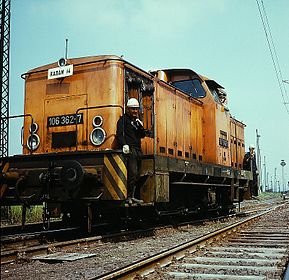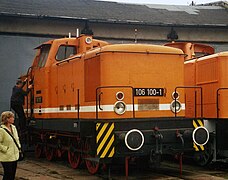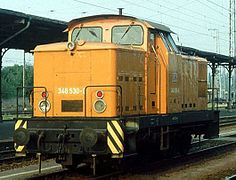DR series V 60
| DR series V 60 | |
|---|---|
|
DR 106 362
|
|
| Numbering: | V 60 10 : V 60 1001–1170 V 60 12 : V 60 1201–1610 106 001–170 106 181–185 (works locomotives) 106 201–999 105 001–165 105 965..991 (works locomotives) |
| Number: | 2256 (with works locomotives) |
| Manufacturer: |
LKM Babelsberg (V 60 10 ) LEW Hennigsdorf (V 60 12 ) |
| Year of construction (s): | 1959 ( prototype ) 1962–1964 V 60 10 1964–1982 V 60 12 |
| Retirement: | 1992ff. |
| Axis formula : | D. |
| Length over buffers: | 10,880 mm |
| Smallest bef. Radius: | 80 m |
| Empty mass: | 55.0 t (V 60 10 ) 60.0 t (V 60 12 ) |
| Wheel set mass : | 13.75 t (V 60 10 ) 15.0 t (V 60 12 ) |
| Top speed: | 30 km / h (shunting gear ) 55 km / h (V 60.10) / 60 km / h (V 60.12) (route) |
| Hourly output : | 478 kW 365 kW (344 series) |
| Performance indicator: | 8.7 kW / t (V 60 10 ) 8 kW / t (V 60 12 ) |
| Motor type: | 12 KVD 18/21 |
| Motor type: | 12-cylinder four-stroke |
| Rated speed: | 1500 rpm |
| Number of traction motors: | 1 |
| Drive: | diesel-hydraulic |
| Brake: | Train brake: indirectly-acting K-brake, direct-acting additional brake, handbrake on all wheelsets |
| Train control : | Sifa |
The vehicles of the series V 60 of the Deutsche Reichsbahn are diesel-hydraulic shunting locomotives for the medium-heavy shunting service.
In addition to being used by the Reichsbahn, the locomotives were also used on various works and mine railways . About 25 percent of the locomotives were exported in CMEA countries, and will in the NSW . The Egyptian State Railways , the BDŽ and the SNTF received these locomotives.
history
From 1955, Lokomotivbau Karl Marx Babelsberg developed the V 60 D series for medium-heavy shunting services as part of the new build range . The locomotives were given the designation V 60 at the Deutsche Reichsbahn , after the change of the numbering system (on July 1, 1970) the designation series 106 . After the last position in the series was assigned to the 106 999 , the machines built subsequently were listed as the 105 series , as the 107 series was already occupied by the 107 series . There were no technical differences between the two series.
The series family also included 81 locomotives of the 104 series with throttled and optimized engines and 14 broad gauge V 60s for the Sassnitz / Mukran ferry port.
With the introduction of the common numbering scheme of the Bundesbahn and Reichsbahn on January 1, 1992, the 104 series became the 344 series ; from the 105 series the 345 series ; from the actual 106 the series 346 and from the remaining broad gauge machines the series 347 .
Specification book

The DR diesel locomotive type program set up in the 1950s provided for a class V 60 with around 650 hp (478 kW) drive power for shunting service. It was intended to replace the series 89, 91 and 92 tank locomotives previously used in shunting services. The requirements for the locomotives included an axle travel mass of less than 15 t, a gearbox with shunting and routing, good cornering ability up to 80 m radii, driving on overflow mountains with 400 m radius in the approach curve and 300 m radius in the discharge curve, less Noise level for good perception of the maneuvering signals, one-man operation as well as safe ride options for the shunting personnel. The locomotives were intended for medium-heavy shunting service and light local freight train service; heavy shunting service should be able to be managed in double traction .
prototype
LKM Babelsberg built a four-axle prototype locomotive with an asymmetrically arranged driver's cab and drive via a jackshaft and coupling rod based on the specifications . The supercharged eight-cylinder engine 8 KVD 21 A from VEB Motorenwerk Johannisthal was used as the engine . Testing of the V 60 1001 prototype began on February 5, 1959. In September 1959, the second V 60 1002 model followed.
Series locomotives
346 530 (V 60.12) in Stendal station
345 375-0 ( MEG locomotive 75) in Rüdersdorf near Berlin
Since the engine of the prototypes did not prove itself, the twelve-cylinder type 12 KVD 18/21 was used for the series, which was also used as a supercharger engine in the series V 100 and V 180 (the later series families 201-204 and 228). In the V 60, the unit was used as a naturally aspirated engine . In addition, design changes were made (different gear shifting, reinforced frame), which were tested in a small series from 1961 , consisting of the locomotives V 60 1003-1007. In 1962 LKM Babelsberg began delivering 163 series V 60 10 locomotives , which lasted until 1964. Although the locomotives were quite convincing, there was still room for improvement, so LKM built a sample of an improved V 60 12 variant . The incorporation of 5 tons of cast iron - Ballast was the friction composition of 55 t to 60 t increased to. The most noticeable distinguishing feature from the older V 60s is the driver's cab, which now extends over the entire width of the frame and has a sun protection roof. After the type V 60 1201 was still built by LKM, the series production of the new locomotive was taken over by Lokomotivbau Elektrotechnische Werke "Hans Beimler" Hennigsdorf .
In the EDP numbering plan from 1970, both V 60 variants became the 106 series. When the 106 999 was delivered in 1975, this number range was completely occupied. Since a class 107 already existed, the following locomotives were named class 105. In 1982, the 105 165, the last locomotive of this type, was delivered to the DR. Some of the locomotives bought later by the Reichsbahn were also numbered in the class 105, they received 900 serial numbers.
With 2,256 units, the locomotive is one of the most frequently built European standard gauge locomotives. 188 locomotives were built in Babelsberg, the others in Hennigsdorf.
Series 347
In 1986, the last major transport project in the GDR was the new Mukran ferry port near Sassnitz . The ferry port primarily served as a trouble-free connection between the GDR and the former USSR . In 1989, five rail ferries ran in regular service between Mukran and Klaipėda (Memel) in Lithuania . Since the Soviet railways have a larger gauge (1520 mm) , the railway ferries and the 340 hectare port station were built with 48 kilometers of standard gauge as well as 24 kilometers of broad gauge tracks. In order to cope with the loading, unloading and shunting tasks that arise there, the DR decided to re-track 14 locomotives of the 105 and 106 series to 1520 mm and to equip them with UIC intermediate buffer couplings of the Intermat type, which can be coupled with the SA3 type. For the conversion, machines were selected that had already been prepared by the manufacturer for the installation of the central buffer coupling. The machines, which can only be used in the wide-gauge section of the Mukran ferry station , have multiple controls and are usually used in double traction . From 1992 they were given the new series number 347 to better distinguish them from the standard gauge machines. Since the train traffic to Lithuania has since declined, Deutsche Bahn AG has decommissioned numerous broad gauge locomotives. In 2016, three machines of the 347 series were still leased to the Baltic Port Rail Mukran.
Series 344
Because the 105/106 series could not be used economically at many train stations because of long idle and part-load times, from the mid-1980s onwards, looking for ways to make the V 60 more economical. In the 106,900 long period of time was a six-cylinder engine with 496 hp performance tested which, although to a lesser fuel consumption led, however, required a high conversion effort. The re-engine plan was therefore abandoned and the existing twelve-cylinder engine of the V 60 was reduced to 1,100 rpm and 496 hp and the permissible top speed to 55 km / h. In addition, a new electronically controlled fluid flow transmission with only one starting and slowing converter was provided, which enabled almost the same starting and continuous pulling power in the lower speed range as with the 650 hp engine. Mathematically, the changes resulted in fuel savings of 15 t per machine and year. In 1991 the series conversion of locomotives into the new series 344 began. DB Cargo regarded these machines as splinter designs and were the first to retire.
construction
The welded main frame of the locomotives is particularly stable in order to absorb the bumps that are typical for shunting work. The buffer beams are wear parts particularly easy to replace. A cover plate with openings downwards is welded onto the frame. To increase cornering ability, two sets of wheels are combined to form a Beugniot frame , in which they can each move 25 mm laterally. The frame is supported by leaf springs on each wheel set. The longer front stem houses the cooler, diesel engine, transfer case, light starter and fan generator, while the rear stem contains the tanks for fuel and compressed air as well as the batteries .
In the first series, a 12KVD18 / 21 type 2 diesel engine was used to generate power, and later a further developed type 3. The engine is a twelve-cylinder, four-stroke prechamber engine without supercharging and develops 650 hp (478 kW) at 1,500 rpm. The power flow from the engine initially takes place via a torsionally flexible coupling and a short cardan shaft to the step-up drive of the fluid-flow transmission GSR 12 / 5.1 with start-up converter and two clutches. The secondary gearbox is flange-mounted directly to the fluid transmission, which switches automatically depending on the driving speed. It enables the direction of travel to be changed as well as switching between maneuvering and driving gear. The rear-mounted gearbox allows 60 km / h in cross gear and 30 km / h in shunting gear with a correspondingly higher tractive effort. The jackshaft is driven by gears. All wheel sets are connected to one another via coupling rods. The fan generator and the light starting machine are also driven via the transfer case installed on the engine .
Locomotives built from 1970 onwards received more efficient fluid drives of the type GS 12 / 5.2.
The locomotives have an indirect Knorr brake as a train brake and an additional direct brake. All wheelsets are braked from the front on one side. As a special feature, the handbrake works on all wheel sets so that the locomotives are suitable for steep routes . The locomotives are equipped with a safety driving circuit, some units are also equipped with shunting radio and train radio .
commitment
After the German reunification and the subsequent merger of the two German state railways, the DB series V 60 , now called series 362–365, and DR V 60 (redrawn as series 344–347) were available. In a comparison of both machines, the West-V 60 performed better due to its lower consumption and the already retrofitted radio remote control, so that the DR series V 60 was gradually shut down. The machines were not sold on, but scrapped. Many former works locomotives are still in use at various private railway companies. In 2014, under the umbrella of DB, only the DB long-distance traffic division owned a few 345/346, in addition, a few broad gauge machines of the 347 series were still active in the Mukran ferry port .
The series was used primarily in the middle-class shunting service to push or let trains run off the shunting mountains of the stations. Other areas of application were the provision of heavy block trains from factories and for local goods trains as well as so-called unloaders.
Some class 106 locomotives had special equipment for special tasks, for example pantographs for contact wire control when used with overhead line assembly trains or central buffer couplings for the transport of underground or S-Bahn cars.
Painting
In the first series, the original paintwork was red with white stripes, later in a yellowish shade. When the yellowish hue got a bit older and dirtier, the then golden-brown paint was reminiscent of a grilled chicken. Therefore, locomotives in this color were given the nickname Goldbroiler .
literature
- Wolfgang Glatte: Simply indestructible. The V 60.10 / 12 series . In: LOK MAGAZINE . No. 254 / Volume 41/2002. GeraNova Zeitschriftenverlag GmbH Munich, ISSN 0458-1822 , pp. 36–49.
- Michael Lüdecke: Series V 60.10. In the driver's cab . In: LOK MAGAZINE . No. 258 / Volume 42/2003. GeraNova Zeitschriftenverlag GmbH Munich, ISSN 0458-1822 , pp. 52–55.
- Lothar Weber: The gold broiler - The series V 60 of the DR Verlag transpress , Stuttgart, ISBN 978-3-613-71490-8
Web links
Individual evidence
- ↑ Klaus Kampelmann, Oliver Strüber: Hesitant start and slow progress . In: railway magazine . No. 4 , 2020, p. 45 .
- ↑ MEG locomotive inventory
- ^ Rail vehicles from Hennigsdorf near Berlin , Verlag Neddermeyer, Berlin 2006, ISBN 978-3-933254-72-6
- ↑ Harm Sievers: On the broad gauge to the east. Positive prospects for the Sassnitz / Mukran ferry port. In: Güterbahnen, Issue 1/2009, pp. 32–35, Alba Fachverlag, Düsseldorf, ISSN 1610-5273
- ↑ Lothar Weber: The gold broiler - The series V 60 of the DR









